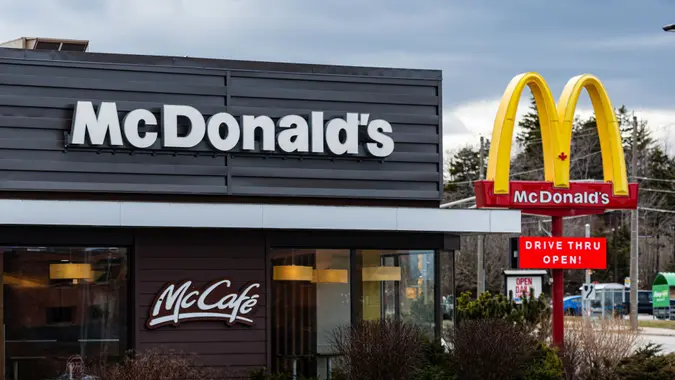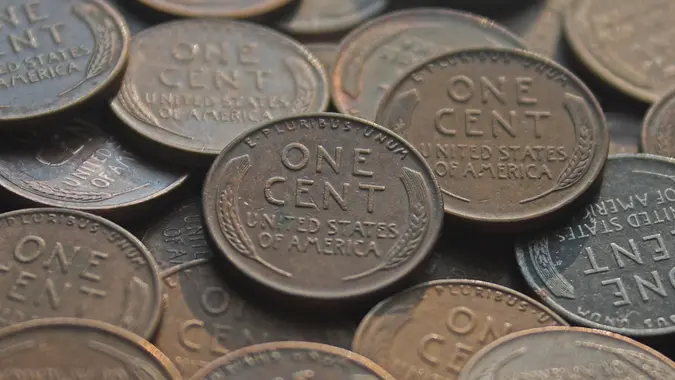How Cost of Living Could Get Worse Under Both Harris and Trump

Commitment to Our Readers
GOBankingRates' editorial team is committed to bringing you unbiased reviews and information. We use data-driven methodologies to evaluate financial products and services - our reviews and ratings are not influenced by advertisers. You can read more about our editorial guidelines and our products and services review methodology.

20 Years
Helping You Live Richer

Reviewed
by Experts

Trusted by
Millions of Readers
Millions of Americans struggling with the impact of inflation are looking to the presidential candidates for relief. After all, the economy has been a key topic of discussion on the campaign trail this election season.
Former President Donald Trump and Vice President Kamala Harris have come up with some details about their economic plans if they win in November. Though they disagree on many key points, there are some overlapping ideas in their plans.
Doubts About Their Plans
Trump and Harris have each talked about their economic plans and how they’d fight inflation if they win the election. But analysts and skeptics on both sides of the political aisle are casting serious doubts that the plans announced so far would do much to lower prices.
“Only two fiscal policy levers can moderate demand and broadly slow increases in the price level: reducing federal spending or raising taxes,” Howard Gleckman, senior contributor, wrote in Forbes. “And neither candidate has offered plans to do either one.”
The Candidates on Taxes
Outside of Trump and Harris calling for the elimination of taxes on income that comes from tips, the two candidates have very different approaches for how they’d deal with taxes if they win in November.
Trump has called for an end to personal income tax in exchange for tariffs on imported goods. While many Americans would like to pay less in taxes, there are concerns the Trump tariff plan would increase prices and essentially act as a tax on American consumers. In fact, the non-partisan Peterson Institute for International Economics predicted an average middle-class household would see an estimated $1,700 a year in additional costs with the tariffs plan.
Harris has plans for an opportunity economy focused on the middle class. It includes tax relief for tens of millions of middle-class and lower-income families. As with Trump’s plans, there are concerns about how the proposed tax cuts under Harris would be paid for and how much they’d help the average American.
Fighting Higher Prices
Harris has said she wants a federal ban on price-gouging on food and groceries. It’s a plan that has drawn a lot of criticism.
“A common charge of the left wing of American politics is that firms fuelled inflation during the COVID-19 pandemic by taking advantage of shortages to jack up prices,” according to The Economist. “But researchers with the Federal Reserve have concluded that there was no evidence of higher markups at the aggregate level, which would have been a precondition for pricing decisions to truly cause inflation.”
Going After the Opponent
It’s probably no surprise the two presidential candidates are going after each other’s plans for the economy and fighting inflation and lowering prices. For instance, Harris and others have raised concerns about Trump’s tariff proposal and how it would be paid for. Trump’s alma mater, Penn Wharton, University of Pennsylvania, estimated that Trump’s broader economic policies would result in a $4.1 trillion deficit.
Trump claims his trade policies would create enough long-term growth to make up for the short-term costs of his broader economic policies, CNBC reported. However, Mark Zandi, chief economist at Moody’s, said in an interview with NBC News that the tariffs would likely generate just $2.5 trillion in revenue.
More generally, economists warn that a tariff policy like Trump’s would trigger inflation just as price increases have slowed.
Trump and other critics have said Harris’s plans will continue where Biden’s leave off and America will still see the effects of inflation and higher prices. Harris herself has worked during campaign stops to talk about some differences between her plans and those of the Biden administration.
“Nevertheless, Ms. Harris’s cost-of-living plan may mark the start of a new phase in America’s worrying odyssey,” according to The Economist. “The Democratic presidential candidate takes aim at four categories of costs: housing, groceries, medical and taxes. Although some of her ideas are good, many more would drive up prices — the exact opposite of their intended effect.”
It’s important to keep in mind that Trump and Harris are likely to share more details about their economic plans ahead of the election. Those additional plans could affect how much their ideas would cost the nation and impact individual Americans.
Editor’s note on election coverage: GOBankingRates is nonpartisan and strives to cover all aspects of the economy objectively and present balanced reports on politically focused finance stories. You can find more coverage of this topic on GOBankingRates.com.
 Written by
Written by  Edited by
Edited by 

























